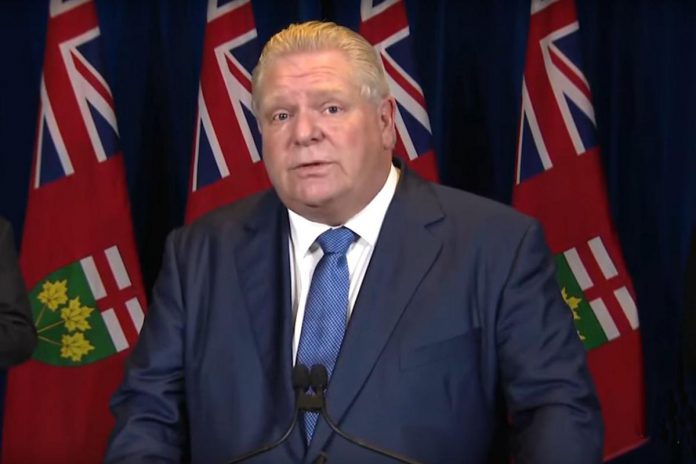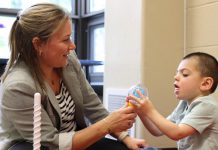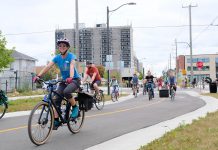
Two days after Ontario reported a record-high 18,445 new COVID-19 cases and with more than 1,200 infected people being treated in hospitals, the provincial government has announced additional public health measures in an attempt to reduce the rapid spread of the omicron variant and reduce its impact on the health care system.
Effective January 5, Ontario will be limiting social gatherings to five people indoors and 10 outdoors, closing indoor dining at restaurants and bars, closing gyms, and closing indoor concert venues, theatres, cinemas, museums, galleries, and more. The measures will remain in effect for at least three weeks.
The province is also delaying the return of students to in-person learning by at least two weeks until January 17, moving schools online, and instructing hospitals to pause all non-emergent and non-urgent surgeries and procedures.
The government is describing the restrictions as a “modified” version of the province’s Step Two of the Roadmap to Reopen, which was in effect in June and July last year.
“We face a tsunami of new cases in the days and weeks ahead and, as we do, virtually everyone in this province will know someone who has been exposed to this virus,” said Premier Doug Ford at Queen’s Park on Monday (January 3), during his first media conference since December 17.
“Now, we’re bracing for impact. Based on our real-world experience here in Ontario, the evidence tells us that about one per cent of people who get omicron will end up in the hospital. That may not seem a lot and, under past waves, it might have been something we could withstand. But omicron isn’t like the other variants — it’s much, much more transmissible, so the math isn’t on our side.”
“Based on the current trends, our public health experts tell us we could see hundreds of thousands of cases every single day,” Ford said. “One per cent of hundreds of thousands is too many new patients for our hospitals to handle. Over the past few days, we’ve started to see an alarming number of new hospital admissions now, with triple-digit admissions into hospitals every single day.
Ford added that people infected with omicron who are admitted to hospital are leaving soon after, “sometimes only staying for a couple of days,” as opposed to weeks in intensive care units with previous variants.
“But even so, with omicron surging across Ontario at the current rate, Ontario health modelling tells us we could be thousands of beds short in the coming weeks,” Ford said. “We can’t let that happen. This data is a clear call for further action. We must do everything in our powers to protect our hospitals and to ensure our frontline workers aren’t overwhelmed.”
Ford said that, while the province has been adding new hospital beds over the past months and will continue to do so, “added capacity alone isn’t enough — we need to implement measures that further reduce contacts and mobility.”
Effective at 12:01 a.m. on Wednesday, January 5th, the following public health restrictions go into effect:
- Reducing social gathering limits to five people indoors and 10 people outdoors.
- Limiting capacity at organized public events to five people indoors.
- Requiring businesses and organizations to ensure employees work remotely, unless the nature of their work requires them to be onsite.
- Limiting capacity at indoor weddings, funerals, and religious services, rites and ceremonies to 50 per cent capacity of the particular room. Outdoor services are limited to the number of people that can maintain two metres of physical distance. Social gatherings associated with these services must adhere to the social gathering limits.
- Limiting capacity at retail settings, including shopping malls, to 50 per cent capacity. For shopping malls, physical distancing is required in line-ups, loitering is not permitted, and food courts are required to close.
- Limiting personal care services to 50 per cent capacity, along with other restrictions. Saunas, steam rooms, and oxygen bars must close.
- Closing indoor meeting and event spaces with limited exceptions, but permitting outdoor spaces to remain open with restrictions.
- Limiting public libraries to 50 per cent capacity.
- Closing indoor dining at restaurants, bars, and other food or drink establishments. Outdoor dining with restrictions, takeout, drive through, and delivery is permitted.
- Restricting the sale of alcohol after 10 p.m. and the consumption of alcohol on-premise in businesses or settings after 11 p.m., with delivery and takeout, grocery and convenience stores, and other liquor stores exempted.
- Closing indoor concert venues, theatres, cinemas, with rehearsals and recorded performances permitted with restrictions.
- Closing museums, galleries, zoos, science centres, landmarks, historic sites, botanical gardens and similar attractions, amusement parks and waterparks, tour and guide services and fairs, rural exhibitions, and festivals. Outdoor establishments are permitted to open with restrictions and with spectator occupancy, where applicable, limited to 50 per cent capacity.
- Closing indoor horse racing tracks, car racing tracks, and other similar venues. Outdoor establishments are permitted to open, with restrictions and with spectator occupancy limited to 50 per cent capacity. Boat tour are permitted at 50 per cent capacity.
- Closing indoor sport and recreational fitness facilities, including gyms, except for athletes training for the Olympics and Paralympics and select professional and elite amateur sport leagues. Outdoor facilities are permitted to operate, but with the number of spectators not to exceed 50 per cent occupancy and other requirements.
For a full list of public health measures, visit covid-19.ontario.ca/public-health-measures. The measures will remain in effect for at least 21 days (until January 26).
In addition, the province is delaying the return of students to in-person learning at all publicly funded and private schools until at least Monday, January 17th. All schools will move to remote learning beginning Wednesday, January 5th.
School buildings will be allowed to remain open for child care operations (including emergency child care), to provide in-person instruction for students with special education needs who cannot be accommodated remotely, and for staff who are unable to deliver quality instruction from home.
During the remote learning period, the government will provide free emergency child care for school-aged children of health care and other eligible frontline workers.
Also on January 5, the Chief Medical Officer of Health will reinstate “Directive 2” for hospitals and regulated health professionals, instructing hospitals to pause all non-emergent and non-urgent surgeries and procedures to preserve critical care and human resource capacity in the health care system.
As for supports for businesses affected by the new measures, Ford said the government would be expanding its new Ontario Business Costs Rebate Program, originally announced on December 22. Under that program, eligible businesses required to close or reduce capacity will receive rebate payments for a portion of the property tax and energy costs they incur while subject to the measures.
Under the original announcement of the program, eligible businesses required to reduce capacity to 50 per cent, such as smaller retail stores, will receive a rebate payment equivalent to 50 per cent of their costs. The program has now been expanded to include businesses required to close for indoor activities (such as restaurants and gyms), which wiill receive a rebate payment equivalent to 100 per cent of their costs.
A full list of eligible business types will be made available when applications for the program open later in January.


























